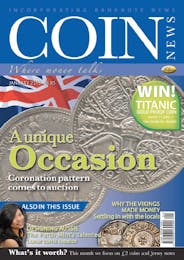Art for art’s sake
THIS MONTH the Royal Mint has released their latest designs for 2013 (you will find details of the £1 coins on the Royal Mint’s Bulletin Page, page 28) and it seems they have gone back to simplistic ideas with the new “floral” reverses of the £1 coins being unadorned by anything other than the most basic rendition of national symbols (the oak and the rose for England, the daffodil and leek for Wales—arguments as to whether the oak and the leek count as “floral” will, undoubtedly come later). The new £2 coin is equally simplistic with a simple London Underground sign rendered artfully to celebrate the “Tube’s” 150th anniversary. The new £5 crown (details of these two coins will appear next month but can be seen at www.tokenpublishing.com now) is set to be just that: a simple depiction of King Edward’s crown to celebrate the 60th anniversary of the Coronation of Her Majesty Queen Elizabeth II. These designs are not an accident—it is obvious that the Mint has taken a conscious decision to tone down the more elaborate designs that have come out of their studios in the past and produce numismatic items that are more basic, although I use this term with no hint of derision I assure you— sometimes the most simplistic things work well and the overdesigned gets messy, as a look at some of our more “artful” coinage in recent years will attest to.
The new Royal Mint designs do not only differ from some of their own work from years gone by, but they also contrast sharply with some offerings from other countries. Phil, our Marketing Director, has the privilege of being one of the judges on Krause Publications’ “Coin of the Year” panel and some of the designs that appeared on the category short-lists this year can only be described as “brave”. Rather than give away how he voted I will simply say that certain designs were so elaborate that it wasn’t easy to see that they were even coins, and others were so over-produced that it made him think that certain Mint’s designers might have too much time on their hands. . . . That isn’t to say the designs were poor, they weren’t, they just weren’t to his taste, although others had apparently found them appealing, hence their inclusion on the short-list. That, of course is the way with coin design: it won’t always be to everyone’s taste. There will be those that hate the final “Coin of the Year”, just as there will be those who love it; those who deride the Royal Mint’s new designs just as much as those who applaud them. Like any art, coin design divides us and rarely do we find one coinage, ancient or modern, that is universally liked. Perhaps the Athenian Owls and other Greek masterpieces are the closest we will get to coinage design that is liked by the majority, but even those gems find their critics. Put ten numismatists in a room with coins from across the ages and I am pretty certain you will get at least nine different opinions on what is the finest design—ten when the two who chose the same coin realise that they had actually agreed on something!
Coin design is part of what makes this hobby so diverse. The fact that we collect miniature works of art as well as date runs and rarities just makes the whole thing that little bit more interesting. But does coin design actually matter outside of our hobby? Does it really make any difference whether we have a beautiful arty piece or a utilitarian “token” that simply states what it is and what it is worth? Does it matter that Mints of the world spend thousands of pounds/dollars/ whatever and thousands of hours coming up with these works of art? Certainly, with the commemorative coins, more akin to medallions than the circulating coinage in our purses and pockets, I can see the value of spending the time and money—these are pieces that are bought as art in many cases. People buy them because they like the design. But the coins we have in use every day? Is there any real need for anything other than the most basic of information on them? There is the issue of counterfeiting of course, but as we have seen, even more elaborate designs fall foul of the criminals, so how a coin looks is hardly a deterrent. Early coins were homage pieces: paying tribute to a god or emperor and their design reflected that deity/ person’s importance, but in the 21st century do we need to do that any more? A coin is a token representing a monetary value (there is no intrinsic value in our coinage now), so shouldn’t it just look as basic as the toy money we played with as children? A denomination, a country of issue and little more? There’s something to be said for that, yes, but I for one am very glad it isn’t the case. In every walk of life aesthetics add value and whether you like or loathe the designs coming out of the World’s Mints this year, I think we can all agree that it is far better that there ARE designs than not. A world where everything is basic and utilitarian would be a very dull world indeed.

Archives
-
2024 (7 articles)
-
2023 (35 articles)
-
2022 (19 articles)
-
2021 (31 articles)
-
2020 (45 articles)
-
2019 (26 articles)
-
2018 (28 articles)
-
2017 (25 articles)
-
2016 (23 articles)
-
2015 (21 articles)
-
2014 (30 articles)
-
2013 (31 articles)
-
2012 (44 articles)
-
2011 (36 articles)
-
2010 (50 articles)
-
2009 (38 articles)
-
2008 (47 articles)
-
2007 (34 articles)
-
2006 (31 articles)
-
2005 (12 articles)
-
2004 (6 articles)
-
2003 (11 articles)
-
2002 (5 articles)
-
2001 (5 articles)









